what does it mean to analyze a writers assumption
Data Analysis: Descriptive Statistics and Assumption Testing
Correlation: Descriptive Statistics and Assumption Testing
Frequency distribution table
| bin | Frequency |
| 2 | 1 |
| 4 | vi |
| 6 | 31 |
| eight | 42 |
| 10 | nineteen |
| 12 | four |
| More than | 0 |
Histogram
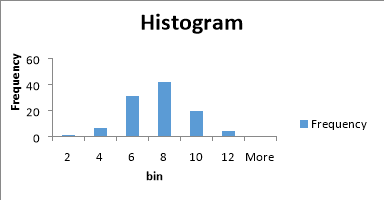
Descriptive statistics table
| Hateful almanac sick days per employee | Descriptive statistics |
| Hateful | vii.126214 |
| Standard Fault | 0.186484 |
| Median | seven |
| Style | 7 |
| Standard Departure | ane.892605 |
| Sample Variance | 3.581953 |
| Kurtosis | 0.124923 |
| Skewness | 0.14225 |
| Range | x |
| Minimum | ii |
| Maximum | 12 |
| Sum | 734 |
| Count | 103 |
Measurement calibration
The minimum and maximum of Mean annual sick days per employee was 2 and 12.
Measure of primal tendency
The analysis shows that mean, median, mode and standard difference of Hateful almanac sick days per employee was 7.126214, 7, 7 and 1.89 respectively.
Evaluation
The Descriptive Statistics shows that the Kurtosis and skewness of Hateful annual ill days per employee is 0.124923 and 0.14225. The assumptions for parametric statistical testing were met here.
Uncomplicated Regression: Descriptive Statistics and Assumption Testing
Frequency distribution table
| bin | Frequency |
| xxx | 2 |
| sixty | nine |
| 90 | xiii |
| 120 | 23 |
| 150 | 29 |
| 180 | 18 |
| 210 | 49 |
| 240 | 31 |
| 270 | 17 |
| 300 | 24 |
| 330 | 4 |
| 360 | 4 |
| More | 0 |
Histogram
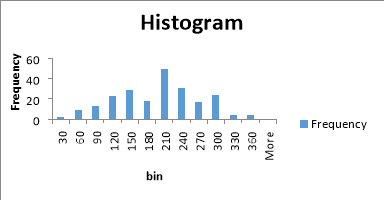
Descriptive statistics table
| lost time hours | Descriptive Statistics |
| Mean | 188.0045 |
| Standard Error | 4.803089 |
| Median | 190 |
| Mode | 190 |
| Standard Deviation | 71.72542 |
| Sample Variance | 5144.536 |
| Kurtosis | -0.50122 |
| Skewness | -0.08198 |
| Range | 350 |
| Minimum | ten |
| Maximum | 360 |
| Sum | 41925 |
| Count | 223 |
Measurement scale
The minimum and maximum of lost fourth dimension hours was 10 and 360.
Measure out of central tendency
The analysis shows that hateful, median, mode and standard divergence of lost fourth dimension hours was 188.0045, 190, 190 and 71.72542 respectively.
Evaluation
The Descriptive Statistics shows that the Kurtosis and skewness of lost time hours is -0.50122 and -0.08198. The assumptions for parametric statistical testing were met hither.
Multiple Regression: Descriptive Statistics and Assumption Testing
Frequency distribution table
| Bin | Frequency |
| 100 | 0 |
| 110 | 36 |
| 120 | 324 |
| 130 | 768 |
| 140 | 373 |
| 150 | ii |
| More | 0 |
Histogram
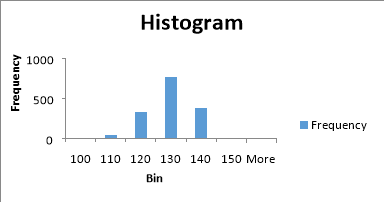
Descriptive statistics table
| Decibel | Descriptive Statistics |
| Mean | 124.8359 |
| Standard Error | 0.177945 |
| Median | 125.721 |
| Mode | 127.315 |
| Standard Deviation | 6.898657 |
| Sample Variance | 47.59146 |
| Kurtosis | -0.31419 |
| Skewness | -0.41895 |
| Range | 37.607 |
| Minimum | 103.38 |
| Maximum | 140.987 |
| Sum | 187628.four |
| Count | 1503 |
Measurement scale
The minimum and maximum of Decibel was 103.38 and 140.9871.
Measure out of fundamental tendency
The assay shows that mean, median, style and standard deviation of Decibel was 124.8359, 125.721, 127.315 and 6.898657 respectively.
Evaluation
The Descriptive Statistics shows that the Kurtosis and skewness of Decibel is -0.31419 and -0.41895. The assumptions for parametric statistical testing were met here.
Independent Samples t Exam : Descriptive Statistics and Supposition Testing
Frequency distribution tabular array
| Bin(Group A Prior Training Scores) | Frequency |
| 50 | 4 |
| 55 | 5 |
| 60 | three |
| 65 | 11 |
| 70 | 9 |
| 75 | ten |
| 80 | eleven |
| 85 | 3 |
| xc | 5 |
| 95 | 1 |
| More than | 0 |
| Bin (Group B Revised Training Scores) | Frequency |
| 75 | 2 |
| 80 | 12 |
| 85 | 21 |
| ninety | nineteen |
| 95 | 6 |
| 100 | ii |
| More | 0 |
Histogram
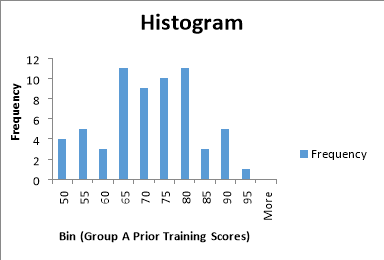
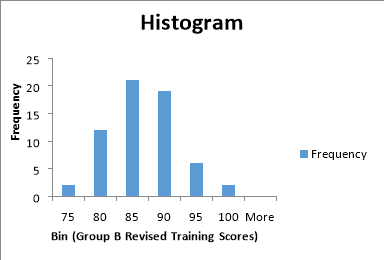
Descriptive statistics table
| Group A Prior Training Scores | Descriptive Statistics | Group B Revised Training Scores | Descriptive Statistics |
| Mean | 69.79032258 | Mean | 84.77419355 |
| Standard Mistake | 1.402788093 | Standard Error | 0.659478888 |
| Median | 70 | Median | 85 |
| Mode | 80 | Mode | 85 |
| Standard Deviation | 11.04556449 | Standard Deviation | 5.192741955 |
| Sample Variance | 122.004495 | Sample Variance | 26.96456901 |
| Kurtosis | -0.77667598 | Kurtosis | -0.352537913 |
| Skewness | -0.086798138 | Skewness | 0.144084526 |
| Range | 41 | Range | 22 |
| Minimum | 50 | Minimum | 75 |
| Maximum | 91 | Maximum | 97 |
| Sum | 4327 | Sum | 5256 |
| Count | 62 | Count | 62 |
Measurement scale
The minimum and maximum of Group A Prior Training Scores was 50 and 91. The minimum and maximum of Group B Revised Grooming Scores was 75 and 97.
Measure of central tendency
The analysis shows that mean, median, mode and standard deviation of Group A Prior Training Scores was 69.79, seventy, eighty and 11.04556 respectively. Similarly, mean, median, mode and standard deviation of Group B Revised Grooming Scores was 84.77, 85, 85 and v.19 respectively.
Evaluation
The Descriptive Statistics shows that the Kurtosis and skewness of Group A Prior Preparation Scores is -0.77667598 and -0.086798138. It as well shows that the Kurtosis and skewness of Grouping B Revised Training Scores is -0.352537913and 0.144084526. The assumptions for parametric statistical testing were met hither.
Dependent Samples (Paired-Samples) t Test: Descriptive Statistics and Assumption Testing
Frequency distribution table.
| Bin (Pre-Exposure μg/dL) | Frequency |
| 6 | 1 |
| 12 | 3 |
| 18 | 4 |
| 24 | 5 |
| 30 | five |
| 36 | 11 |
| 42 | 9 |
| 48 | 7 |
| 54 | 3 |
| sixty | 1 |
| More | 0 |
| Bin (Mail-Exposure μg/dL) | Frequency |
| 6 | 1 |
| 12 | iii |
| 18 | iv |
| 24 | five |
| 30 | 5 |
| 36 | 7 |
| 42 | 12 |
| 48 | 8 |
| 54 | 3 |
| 60 | 1 |
| More | 0 |
Histogram
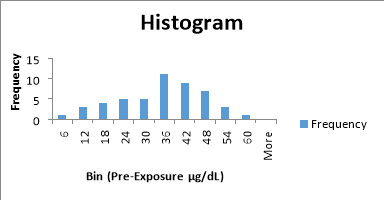
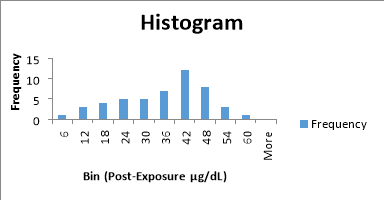
Descriptive statistics table
| Pre-Exposure μg/dL | Descriptive Statistics | Mail service-Exposure μg/dL | Descriptive Statistics |
| Mean | 32.85714 | Mean | 33.28571 |
| Standard Error | 1.752307 | Standard Fault | 1.781423 |
| Median | 35 | Median | 36 |
| Style | 36 | Way | 38 |
| Standard Deviation | 12.26615 | Standard Deviation | 12.46996 |
| Sample Variance | 150.4583 | Sample Variance | 155.5 |
| Kurtosis | -0.57604 | Kurtosis | -0.65421 |
| Skewness | -0.42511 | Skewness | -0.48363 |
| Range | 50 | Range | l |
| Minimum | 6 | Minimum | 6 |
| Maximum | 56 | Maximum | 56 |
| Sum | 1610 | Sum | 1631 |
| Count | 49 | Count | 49 |
Measurement calibration
The minimum and maximum of both Pre-Exposure μg/dL and Mail-Exposure μg/dL was 6 and 56.
Mensurate of central trend
The assay shows that mean, median, style and standard deviation of Pre-Exposure μg/dL was 32.85714, 35, 36 and 12.26615 respectively. Similarly, mean, median, mode and standard difference of Post-Exposure μg/dL was 33.28571, 36, 38 and 12.46996 respectively.
Evaluation
The Descriptive Statistics shows that the Kurtosis and skewness of Pre-Exposure μg/dL is -0.57604 and -0.42511. It also shows that the Kurtosis and skewness of Post-Exposure μg/dL is -0.65421 and -0.48363. The assumptions for parametric statistical testing were met hither.
ANOVA: Descriptive Statistics and Assumption Testing
Frequency distribution table.
| Bin (A = Air) | Frequency |
| ii | 0 |
| 4 | two |
| 6 | 3 |
| 8 | 3 |
| ten | 5 |
| 12 | five |
| 14 | ii |
| More | 0 |
| Bin (B = Soil) | Frequency |
| 6 | one |
| viii | 7 |
| 10 | 8 |
| 12 | three |
| xiv | i |
| More than | 0 |
| Bin (C = Water) | Frequency |
| 2 | 0 |
| 4 | ii |
| half-dozen | ix |
| 8 | iv |
| 10 | ii |
| 12 | 3 |
| More than | 0 |
| Bin (D = Preparation) | Frequency |
| 2 | 0 |
| 4 | 4 |
| half dozen | 13 |
| eight | 3 |
| More | 0 |
Histogram.

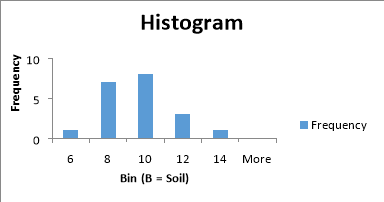

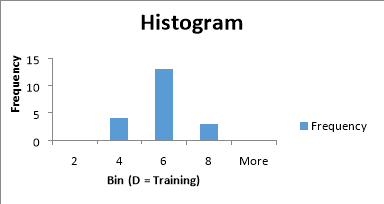
Descriptive statistics tabular array.
| A = Air | Descriptive Statistics | B = Soil | Descriptive Statistics | C = H2o | Descriptive Statistics | D = Training | Descriptive Statistics |
| Mean | 8.9 | Mean | 9.one | Mean | 7 | Mean | 5.4 |
| Standard Error | 0.684028 | Standard Fault | 0.390007 | Standard Fault | 0.575829 | Standard Mistake | 0.265568 |
| Median | ix | Median | 9 | Median | half dozen | Median | 5 |
| Mode | xi | Way | 8 | Way | vi | Fashion | 5 |
| Standard Divergence | 3.059068 | Standard Deviation | i.744163 | Standard Departure | 2.575185 | Standard Deviation | i.187656 |
| Sample Variance | nine.357895 | Sample Variance | iii.042105 | Sample Variance | 6.631579 | Sample Variance | ane.410526 |
| Kurtosis | -0.6283 | Kurtosis | 0.11923 | Kurtosis | -0.23752 | Kurtosis | 0.253747 |
| Skewness | -0.36085 | Skewness | 0.492002 | Skewness | 0.760206 | Skewness | 0.159183 |
| Range | 11 | Range | 7 | Range | 9 | Range | v |
| Minimum | iii | Minimum | 6 | Minimum | 3 | Minimum | iii |
| Maximum | 14 | Maximum | 13 | Maximum | 12 | Maximum | 8 |
| Sum | 178 | Sum | 182 | Sum | 140 | Sum | 108 |
| Count | 20 | Count | xx | Count | xx | Count | 20 |
Measurement scale
The minimum and maximum of air was iii and 14. Similarly, the minimum and maximum of soil was six and 13. The minimum and maximum of water was 3 and 12. Similarly, the minimum and maximum of grooming was 3 and 8.
Mensurate of central tendency
The analysis shows that hateful, median, way and standard difference of air was viii.9, nine, 11 and 3.059068 respectively. Similarly, hateful, median, mode and standard divergence of soil was nine.1, ix, eight and one.744163 respectively. The mean, median, manner and standard deviation of water was seven, vi, 6 and 2.575185 respectively. Similarly, mean, median, mode and standard divergence of grooming was 5.4, v, 5 and 1.187656 respectively.
Evaluation
The Descriptive Statistics shows that the Kurtosis and skewness of Air is -0.6283 and -0.36085. Information technology also shows that the Kurtosis and skewness of soil is 0.11923 and -0.492002. Similarly, the Kurtosis and skewness of water is -0.23752 and 0.760206. Moreover, the Kurtosis and skewness of training is 0.253747 and 0.159183. The assumptions for parametric statistical testing were met hither.
References
Linoff, M. S. (2010). Information Assay Using SQL and Excel. John Wiley & Sons.
Whigham, D. (2007). Business Data Analysis Using Excel. OUP Oxford.
Nirel, R., Adar, South. D., Dayan, U., Vakulenko-Lagun, B., Golovner, M., Levy, I., . . . Peretz, A. (2018). Fine and Coarse Particulate Thing Exposures and Associations with Acute Cardiac Events among Participants in a Telemedicine Service: A Case-Crossover Study. Environmental Health Perspectives, 126(ix), 097003. doi:x.1289/ehp2596
copherminuncen1997.blogspot.com
Source: https://www.ukessays.com/essays/data-analysis/data-analysis-descriptive-statistics-and-assumption-testing.php
0 Response to "what does it mean to analyze a writers assumption"
Post a Comment